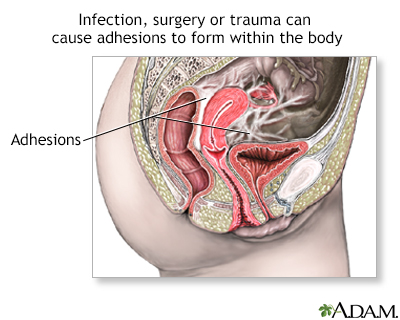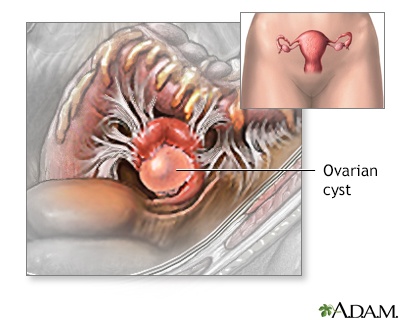Pregnancy SmartSiteTM
Celioscopy; Band-aid surgery; Pelviscopy; Gynecologic laparoscopy; Exploratory laparoscopy - gynecologic DefinitionPelvic laparoscopy is surgery to examine the pelvic organs. It uses a viewing tool called a laparoscope. The surgery is also used to treat certain diseases of the pelvic organs. DescriptionWhile you are deep asleep and pain-free under general anesthesia, the doctor makes a half-inch (1.25 centimeters) surgical cut in the skin below the belly button. Carbon dioxide gas is pumped into the abdomen to help the surgeon see the organs more easily. The laparoscope, an instrument that looks like a small telescope with a light and a video camera, is inserted so the surgeon can view the area. Other instruments may be inserted through other small cuts in the lower abdomen. While watching a video monitor, the surgeon is able to:
After the laparoscopy, the carbon dioxide gas is released, and the cuts are closed. Why the Procedure is PerformedLaparoscopy uses a smaller surgical cut than open surgery. Most people who have this procedure are able to return home the same day. The smaller incision also means that the recovery is faster. There is less blood loss with laparoscopic surgery and less pain after surgery. Pelvic laparoscopy is used both for diagnosis and treatment. It may be recommended for:
A pelvic laparoscopy may also be done to:
RisksRisks of any pelvic surgery include:
Laparoscopy is safer than an open procedure for correcting the problem. Before the ProcedureAlways tell your health care provider:
During the days before surgery:
On the day of your surgery:
After the ProcedureYou will spend some time in a recovery area as you wake up from the anesthesia. Many people are able to go home the same day as the procedure. Sometimes, you may need to stay overnight, depending on what surgery was done using the laparoscope. The gas pumped into the abdomen may cause abdominal discomfort for 1 to 2 days after the procedure. Some people feel neck and shoulder pain for several days after a laparoscopy because the carbon dioxide gas irritates the diaphragm. As the gas is absorbed, this pain will go away. Lying down can help decrease the pain. You will get a prescription for pain medicine or be told what over-the-counter pain medicines you can take. You may go back to your normal activities within 1 to 2 days. However, DO NOT lift anything over 10 pounds (4.5 kilograms) for 3 weeks after surgery to decrease your risk of getting a hernia in your incisions. Depending on what procedure is done, you can usually begin sexual activities again as soon as any bleeding has stopped. If you have had a hysterectomy, you need to wait a longer period before having sexual intercourse again. Ask your surgeon what is recommended for the procedure you are having. Contact your surgeon if you have:
ReferencesBurney RO, Giudice LC. Endometriosis. In: Robertson RP, ed. DeGroot's Endocrinology: Adult and Pediatric. 8th ed. Philadelphia, PA: Elsevier; 2023:chap 125. Cohen JG, Bixel K, Backes FJ. Role of minimally invasive surgery in gynecologic malignancies. In: Creasman WT, Mutch DG, Mannel RS, Tewari KS, eds. DiSaia and Creasman Clinical Gynecologic Oncology. 10th ed. Philadelphia, PA: Elsevier; 2023:chap 20. Patel RM, Kaler KS, Landman J. Fundamentals of laparoscopic and robotic urologic surgery. In: Partin AW, Dmochowski RR, Kavoussi LR, Peters CA, eds. Campbell-Walsh-Wein Urology. 12th ed. Philadelphia, PA: Elsevier; 2021:chap 14. Raymond L, Lentz GM. Endoscopy in minimally invasive gynecologic surgery. In: Gershenson DM, Lentz GM, Valea FA, Lobo RA, eds. Comprehensive Gynecology. 8th ed. Philadelphia, PA: Elsevier; 2022:chap 10. | ||
| ||
Review Date: 3/31/2024 Reviewed By: LaQuita Martinez, MD, Department of Obstetrics and Gynecology, Emory Johns Creek Hospital, Alpharetta, GA. Also reviewed by David C. Dugdale, MD, Medical Director, Brenda Conaway, Editorial Director, and the A.D.A.M. Editorial team. View References The information provided herein should not be used during any medical emergency or for the diagnosis or treatment of any medical condition. A licensed medical professional should be consulted for diagnosis and treatment of any and all medical conditions. Links to other sites are provided for information only -- they do not constitute endorsements of those other sites. No warranty of any kind, either expressed or implied, is made as to the accuracy, reliability, timeliness, or correctness of any translations made by a third-party service of the information provided herein into any other language. © 1997- A.D.A.M., a business unit of Ebix, Inc. Any duplication or distribution of the information contained herein is strictly prohibited. | ||


 Pelvic laparoscopy
Pelvic laparoscopy Endometriosis
Endometriosis Pelvic adhesions
Pelvic adhesions Ovarian cyst
Ovarian cyst
